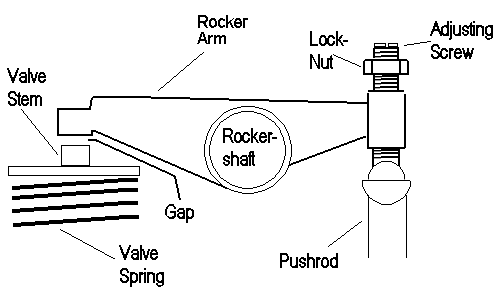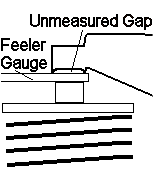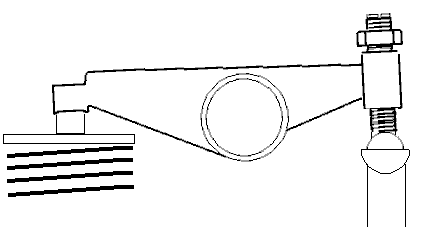
Valve Actuation
The diagram below shows the essential
components of a valve actuator. The pushrod rises and falls by action of
the camshaft and in doing so, moves one end of the rocker arm upward too.
The rocker is pivoted on its shaft so that upward movement on one end (right)
results in downward movement toward the valve stem against the force of
the valve spring that is pushing the valve stem upward and tending to keep
the valve closed.

So:
Number 1 valve is adjusted when number
8 is fully open.
Number 2 valve is adjusted when number
7 is fully open
Number 3 valve is adjusted when number
6 is fully open
Number 4 valve is adjusted when number
5 is fully open
Number 5 valve is adjusted when number
4 is fully open
Number 6 valve is adjusted when number
3 is fully open
Number 7 valve is adjusted when number
2 is fully open
Number 8 valve is adjusted when number
1 is fully open
To adjust a valve clearance, a feeler gauge
is usually placed between the valve stem and the rocker.
 As
shown in the picture at left, when the rocker has worn, the measured gap,
which is the thickness of the feeler gauge, is less than the actual gap,
the feeler gauge failing to measure the concave wear point. This results
in the valve opening less than it should, (adversly affecting performance),
slightly off valve timing and above all, very noisy tappets.
As
shown in the picture at left, when the rocker has worn, the measured gap,
which is the thickness of the feeler gauge, is less than the actual gap,
the feeler gauge failing to measure the concave wear point. This results
in the valve opening less than it should, (adversly affecting performance),
slightly off valve timing and above all, very noisy tappets.
 The
Clikadjust method of tappet adjustment does not use a feeler gauge, instead
the adjusting screw is tightened to a known point; that where the gap is
zero. The tool design ensures that lock-nut remains backed off sufficiently
so that it does not restrict the movement of the screw, which might be
mistaken for a contact between the rocker arm and valve stem, and give
a false zero gap point.
The
Clikadjust method of tappet adjustment does not use a feeler gauge, instead
the adjusting screw is tightened to a known point; that where the gap is
zero. The tool design ensures that lock-nut remains backed off sufficiently
so that it does not restrict the movement of the screw, which might be
mistaken for a contact between the rocker arm and valve stem, and give
a false zero gap point.
Depending on the pitch of the adjusting screw and the lengths of the rocker arms, each degree it is backed-off, corresponds to a certain increase in tappet gap. The Clikadjust is a specialized screwdriver that provides an audible click for every 1/30 (12° ) of a full turn so that for a given rocker arm and adjusting screw, a given number of clicks equates to opening the gap from zero to a certain gap distance.
However, if the number of clicks is not known for a car, then it may be found by using a feeler gauge. Although a feeler gauge may not be an accurate method of determining absolute gap on a worn tappet, it can measure the difference in gap very well. If we use the example of a 0.015" (15 thou) gap.
Adjust the valve stem to rocker clearance so that a 0.010 (10 thou) feeler gauge can just enter it.
Using the Clikadjust, back off the adjustment screw, counting the clicks, until it can accept the 0.010" feeler gauge plus the required gap; in this example that's 0.010 + 0.015 = 0.025 (or 25 thou). The number of clicks counted is the required information.
Make a note the number of clicks ready for next time.
For the Best Value in Gunson Products, contact Little British Car Co